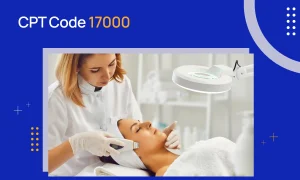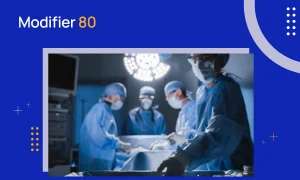Lesion removal is a common procedure in dermatology. But why is it that even professional coders get confused when it comes to this procedure’s coding and billing? The main reason is that you can’t apply the same code to every excision. The coding specifically depends on several factors, such as the type, size, location, and removal method of these growths. So, yeah, you have choices!
CPT code 17110 is one such option. It is commonly used to report the destruction of benign lesions. For more information and other billing details, read this blog and learn to use this code accurately.
CPT Code 17110 – Description
We have already given a hint about this code in the intro. But let’s discuss it in more detail. CPT code 17110 specifies a destruction procedure to remove a benign or premalignant lesion located on the body’s outer layer (integumentary system). In simple words, it helps you report the destruction of 1 to 14 non-cancerous growths with one of the following techniques:
- Chemosurgery (chemical removal of unwanted growths)
- Cryosurgery (using extremely cold temperatures to freeze and then destroy a benign lesion)
- Electrosurgery (using high electric current to remove a non-cancerous growth)
Healthcare providers, usually dermatologists, perform this procedure for either cosmetic reasons or to reduce a patient’s discomfort. The clinical reason determines the reimbursement rate for this code (we will discuss this later in the billing guidelines).
In short, you can use the 17110 CPT code to specify that you have removed up to 14 non-cancerous lesions within a single session. That’s everything, but remember that this code does not cover the removal of skin tags.
Appropriate Use Cases for CPT Code 17110
Want to increase your understanding of this code further? Here are some real-world examples of CPT code 17110:
Destruction of 5 Seborrheic Keratoses
There are many types of benign skin growths. Among them, seborrheic keratosis is the most common type. It mostly develops in people above 40 and multiplies with age, affecting 30% of people in their 40s and 75% of people above 70.
Therefore, let’s suppose a middle-aged man arrives at a dermatology clinic with this type of growth on his face, neck, and chest. Due to his symptoms, which include itching and irritation, the dermatologist uses cryotherapy to destroy 5 seborrheic keratoses. Since all the lesions were benign, he uses CPT code 17110 to bill for their removal.
Using Cryotherapy to Remove Warts
Warts are another type of non-cancerous lesion. Almost all warts are due to human papillomavirus (HPV), which infects nearly 13 million Americans annually. So, let’s consider a teen with multiple warts on his face. His mother takes him to a dermatologist.
Due to the contagious nature of these lesions and the boy’s increasing discomfort, the dermatologist uses liquid nitrogen to freeze the warts. He then reports this service with CPT code 17110.
Removing an Atypical Mole
Most atypical moles, also known as dysplastic nevi (occurring in about 1 in 10 people in the U.S.), are not precancerous. However, they can develop into melanoma. Therefore, healthcare providers usually recommend their removal.
Let’s assume a construction worker visits a dermatologist after noticing an atypical mole on his neck. Let’s also suppose that the mole is brown in color and is asymmetrical with blurry borders. After a thorough evaluation and some tests, the healthcare provider determines that it is non-cancerous.
However, the patient does not want to take any risks and asks for this mole to be removed. Therefore, the dermatologist removes it via electrosurgery and uses CPT code 17110 to bill for it.
Modifiers to Append with CPT Code 17110
You can use the following modifier with CPT code 17110.
Modifier 59
This modifier is suitable for distinguishing two separately identifiable services. Therefore, if the destruction of a benign lesion was distinct from other services you performed on the same patient and on the same day, use modifier 59 with CPT code 17110.
Reimbursement Guidelines for CPT Code 17110
Let’s get to the most important part of any code, the reimbursement guidelines. For complete reimbursements, always keep the following details in mind:
Report 17110 for the Destruction of Benign Lesions
We have briefly mentioned this in the description! CPT code 17110 does not cover the removal of skin tags and cancerous growths. Therefore, use it to bill for the medically necessary removal of benign lesions, which takes us to the next important detail.
Verify Medical Necessity
The majority of payers (and yes, this includes commercial insurers) only cover CPT code 17110 if it is medically necessary. This may involve the destruction of acquired or small congenital nevi, seborrheic keratoses, sebaceous cysts, or any other non-cancerous growth. Therefore, avoid using it to report or bill for cosmetic excisions.
Document the Procedure
Your documentation must also support the medical necessity of CPT code 17110. This includes key information, like:
- Symptoms
- Clinical reason for removing benign lesions (e.g., to improve daily function, reduce irritation or discomfort, or to avoid cancer risk)
- Procedure details (location, number of lesions destroyed, and destruction method)
Avoid Common Mistakes
Even if the application of a code seems straightforward to you, always verify its coverage policies with different payers. For example, Medicare tells you not to waste your energy by submitting a claim for cosmetic purposes. Other common mistakes include:
- Billing multiple units of CPT code 17110 for the same session.
- Using this code to report the destruction of the first 14 lesions (you can use it to bill for the removal of up to any 14 lesions).
- Bundling 17110 with 17111.
Final Thoughts on CPT Code 17110
CPT code 17110 is as straightforward as it seems. It has a simple description and billing rules. You can use it to report the destruction of up to 14 benign lesions via different methods. We have tried to provide all the necessary details about this code through this blog. However, if we still missed out on any detail, you can contact our team. Our dermatology billing services are a complete package, offering unmatched coding accuracy.



